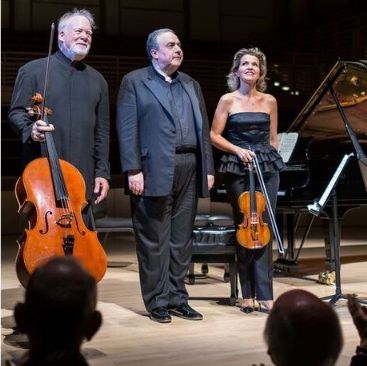|
Symphony
FROM THE NEW WORLD TO THE OLD WORLD
by Peter Lert
Saturday, June 14, 2025
Chamber
MC2 DUO RECITAL CLOSES 222'S SEASON
by Terry McNeill
Saturday, June 14, 2025
Choral and Vocal
CANTIAMO SONOMA'S LUSCIOUS A CAPELLA SINGING IN SEASON ENDING CONCERT
by Pamela Hicks Gailey
Sunday, June 8, 2025
Symphony
SRS SEASON ENDS WITH RESOUNDING TA-TA-TA-BANG
by Terry McNeill
Sunday, June 1, 2025
Symphony
YOUTHFUL VIRTUOSITY ON DISPLAY AT USO'S MAY CONCERTS
by Peter Lert
Saturday, May 17, 2025
Symphony
MYSTICAL PLANETS AND LIVELY GERSHWIN ORTIZ AT FINAL SRS CONCERT
by Peter Lert
Sunday, May 4, 2025
Symphony
VSO'S CONCERT MUSIC OF TIME, MUSIC OF PLACE
by Peter Lert
Sunday, April 27, 2025
VOCAL ELEGANCE AND FIRE AT THE 222'S RECITAL APRIL 26
by Pamela Hicks Gailey
Saturday, April 26, 2025
CANTIAMO SONOMA SINGS AN INSPIRED GOOD FRIDAY MOZART REQUIEM CONCERT
by Pamela Hicks Gailey
Friday, April 18, 2025
DRAMATIC SHOSTAKOVICH SYMPHONY CLOSES PHILHARMONIC'S 25TH SEASON
by Terry McNeill
Sunday, April 13, 2025
|
 |
 Muter-Bronfman-Harrell Trio Taking Applause in Weill April 19 (Eisaku Photo) |
STELLAR TRIO PLAYS ICONIC CHAMBER WORKS IN WEILL HALL CONCERT
by Terry McNeill
Sunday, April 19, 2015
Virtuoso instrumentalists frequently get together in a trio for a few concerts with the resulting playing being exciting but the performance sounding a little unfinished. This was decidedly not what happened with the Mutter-Bronfman-Harrell Trio April 19 in Weill, as the two works on the program had been played many times recently during their long American tour.
Beginning with the iconic Beethoven “Archduke” Trio in B-Flat Major, Op. 97, the group chose moderate tempos and eschewed old school extended ritards. Two of the players, cellist Lynn Harrell and pianist Yefim Bronfman, gave the audience of 900 a fresh hearing of their artistry. Mr. Harrell’ s last local appearance in the Dvorak Concerto disclosed a deferential approach, but in this concert he found his footing and was more assertive, though in the opening Allegro he seldom played legato, but used a Louré technique, almost stopping the bow between each note within a slur. Regarding Mr. Bronfman, readers of Classical Sonoma may remember reviews of a coarse and pounding Liszt Sonata in Wells, and a technically brilliant but boring interpretation of the Tchaikovsky B-Flat Concerto on the Weill stage. Here he played with greater individuality, rustic charm and attention to his partner’s phrasing.
And violinist Anne Sophie Mutter? Her playing was solidly artistic with less of the pianissimo sans vibrato that characterized past sonata performances. In the variation that begins well into the Andante Cantabile she played without any vibrato, an expressive choice that can be haunting but in the Beethoven is seemed contrived and strange. She was the suave performer in the Trio with legato phrasing juxtaposed with Mr. Bronfman’s rollicking accented bass notes in the Scherzo.
The last movement, that delightfully skittish and humorous section, demands a lot of clarity but the Hall’s acoustics, especially with the too-fast tempo, made the ensemble sound muddy. The coda was played really presto and the composer’s marvelous combination of excitement, humor and even poignancy was seen from the ensemble but not often heard.
Tchaikovsky’s monumental A Minor Trio, Op. 50, comprised the second half and received a stirring performance that surprisingly didn’t include the usual cuts in the last movement, and especially the fugue variation. Ms. Mutter had unsteady intonation in the first big theme but settled down and with Mr. Harrell didn’t shy away from expressive portamentos. The cellist and violinist didn’t always have the same bowings, odd after so many tour performances of this elegiac Russian piece from 1881.
Mr. Bronfman’s big block chords were heavy handed and he is not colorist (colorists at the piano? Hofmann and Gieseking, and more recently Alicia de Larrocha). However, his playing was expressive and arresting, with the great solo in the first movement Tempo Molto Sostuendo passages and voice leading in the early variations of the Andante con Moto. The Mazurka (Variation 2) was captivating, as was the pedal point for the strings and the delicate treble “music box” piano tinkling in Variation 5.
The music (final variation and coda) ended with instrumental perfection – first appropriately powerful, then gradually subsiding to a lugubrious and ultimately funereal pianissimo. A provocative and suggestive great work, played with compulsion and palpable devotion.
The audience sprang to its feet and demanded three curtain calls, but received no encore from the smiling Trio.
Contributing to this review were Toscha Spalding and Jelly d'Neveu
|

